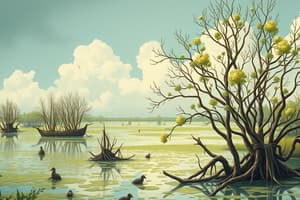Podcast
Questions and Answers
What is the purpose of the students' visit to the nature reserve?
What is the purpose of the students' visit to the nature reserve?
- To collect rare plants
- To learn about ecosystems (correct)
- To engage in competitive sports
- To observe traditional farming methods
What type of ecosystem did Mr. Green's class explore last year?
What type of ecosystem did Mr. Green's class explore last year?
- A forest ecosystem (correct)
- A mountain ecosystem
- A desert ecosystem
- An ocean ecosystem
Which of the following animals was NOT mentioned as being seen by the class last year?
Which of the following animals was NOT mentioned as being seen by the class last year?
- Fish (correct)
- Insects
- Birds
- Foxes
What are the students expected to do after their visit to the wetland ecosystem?
What are the students expected to do after their visit to the wetland ecosystem?
Which of the following best describes a wetland ecosystem?
Which of the following best describes a wetland ecosystem?
What are some of the items the students are packing for their trip?
What are some of the items the students are packing for their trip?
Where are the wetlands primarily found?
Where are the wetlands primarily found?
Which plant type is most likely associated with wetland ecosystems?
Which plant type is most likely associated with wetland ecosystems?
What type of ecosystem will Mr.Green's class explore this year?
What type of ecosystem will Mr.Green's class explore this year?
What is one benefit of studying ecosystems like wetlands?
What is one benefit of studying ecosystems like wetlands?
What kinds of plants and animals are characteristic of a wetland ecosystem?
What kinds of plants and animals are characteristic of a wetland ecosystem?
Which of the following activities are the students NOT planning to do at the nature reserve?
Which of the following activities are the students NOT planning to do at the nature reserve?
Which animal was specifically mentioned as being observed last year during the forest visit?
Which animal was specifically mentioned as being observed last year during the forest visit?
What essential item are students bringing to help with their studies in the ecosystems?
What essential item are students bringing to help with their studies in the ecosystems?
What was included in the plans for the students after returning from the nature reserve?
What was included in the plans for the students after returning from the nature reserve?
Which of the following ecosystems did Mr.Green teach about before the current visit?
Which of the following ecosystems did Mr.Green teach about before the current visit?
Flashcards
Ecosystem
Ecosystem
A place where plants, animals, and their environment live and interact.
Nature Reserve
Nature Reserve
A protected area of land where ecosystems are preserved.
Wetland Ecosystem
Wetland Ecosystem
A place with a lot of water where water plants and animals such as frogs and fish live.
Mr.Green's Class Trip Location
Mr.Green's Class Trip Location
Signup and view all the flashcards
Students' Activity (Now)
Students' Activity (Now)
Signup and view all the flashcards
Previous Ecosystem
Previous Ecosystem
Signup and view all the flashcards
Student Post-Trip Activity
Student Post-Trip Activity
Signup and view all the flashcards
Key Elements in Wetlands
Key Elements in Wetlands
Signup and view all the flashcards
Ecosystem
Ecosystem
Signup and view all the flashcards
Wetland Ecosystem
Wetland Ecosystem
Signup and view all the flashcards
Nature Reserve
Nature Reserve
Signup and view all the flashcards
Class Trip Destination
Class Trip Destination
Signup and view all the flashcards
Students' Current Action
Students' Current Action
Signup and view all the flashcards
Previous Trip Ecosystem
Previous Trip Ecosystem
Signup and view all the flashcards
Post-Trip Activity
Post-Trip Activity
Signup and view all the flashcards
Animals in Wetlands
Animals in Wetlands
Signup and view all the flashcards
Study Notes
Exploring Ecosystems
- Mr. Green's science class is visiting a nature reserve next week to study ecosystems.
- Ecosystems are places where plants, animals, and the environment live together.
- The class will study different ecosystems, including forests, deserts, and wetlands.
- Students are preparing notebooks, cameras, and other materials for the trip.
Previous Year's Trip
- Last year, the class visited a forest ecosystem.
- They observed various animals, including birds, insects, and foxes.
Wetland Ecosystem
- This year's trip focuses on a wetland ecosystem.
- Wetlands have a lot of water and support diverse life forms.
- Students will observe amphibians like frogs, fish, and water plants.
- They will document their observations in notebooks and take pictures.
Learning Objectives
- Students will study how plants and animals live in the wetland ecosystem.
- They will create posters based on their learnings and observations.
Comprehension Questions
- Destination: The class is visiting a nature reserve.
- Ecosystem Definition: An ecosystem is a place where plants, animals, and their environment live together.
- Current Activity: The class is currently packing notebooks and cameras.
- Previous Year's Location: Last year, the class visited a forest ecosystem.
- Animals Observed Last Year: Birds, insects, and a family of foxes.
- Ecosystem This Year: Wetland.
- Animals to Observe This Year: Frogs, fish, and water plants.
Additional Questions (page 2)
- Wetland Study Focus: How plants and animals live in the wetland.
- Materials for Trip: Backpacks, notebooks, and cameras.
- Post-Trip Activity: Students will prepare reports and posters.
- Wetland Inhabitants: Frogs, fish, possibly foxes, might be present.
Studying That Suits You
Use AI to generate personalized quizzes and flashcards to suit your learning preferences.




